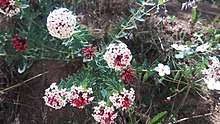Stellera
| Stellera | |
|---|---|
 | |
| Scientific classification | |
| Kingdom: | Plantae |
| Clade: | Angiosperms |
| Clade: | Eudicots |
| Clade: | Rosids |
| Order: | Malvales |
| Family: | Thymelaeaceae |
| Subfamily: | Thymelaeoideae |
| Genus: | Stellera L.[1] |
| Species: | S. chamaejasme |
| Binomial name | |
| Stellera chamaejasme L.[2] | |
Stellera is a genus of flowering plant in the family Thymelaeaceae, with a single species Stellera chamaejasme,[2] found in mountainous regions of central and south Asia. S. chamaejasme is a perennial plant with heads of white, pink or yellow flowers, grown as an ornamental plant in rock gardens and alpine houses.
Description
Stellera chamaejasme is a herbaceous perennial. Unbranched stems, 20–30 cm tall, emerge in a cluster from an underground rhizome. Narrow, overlapping leaves are borne along the stems. Individual leaves are narrow and pointed, up to 2 cm long. The flowers are grouped into rounded tightly packed terminal heads. Flowers lack petals, instead having petaloid sepals forming a tube up to 1.5 cm long with usually five (but possibly four or six) short lobes at the end. The flower colour varies from shades of pink and white to yellow. There are twice as many stamens as calyx lobes, in two series. The ovary has a single chamber (locule). The fruit is a dry drupe, enclosed by the remains of the calyx.[3][4]
Taxonomy
The genus Stellera was first described by Carl Linnaeus in 1753.[1] He recognized two species: Stellera passerina, now placed in the genus Thymelaea as T. passerina, and Stellera chamaejasme.[5] Many species names were later created in the genus, but all are now usually considered synonyms of other species, including S. chamaejasme,[2] although the Flora of China states that there are 10 to 12 species.[4]
Studies in 2002 and 2009, based on chloroplast DNA, placed Stellera in a small group of related genera, either as sister to Wikstroemia or embedded within it; however for most genera only one species was included.[6][7]
|
| |||||||||||||||||||||||||||||||
Distribution and habitat
Stellera chamaejasme is native to northern China, Tibet, the Himalayas (Nepal, Bhutan), Uttar Pradesh in India, and Russia and Mongolia.[3][8] In China, it is found on sunny dry slopes and sandy places between 2600 and 4200 m.[8]
Cultivation
Stellera chamaejasme is cultivated as an ornamental plant in rock gardens and alpine houses. It is considered difficult to grow, needing a sunny position and gritty soil if grown outside, or a large pot if grown under cover. It is propagated by seed.[3]
References
- 1 2 "Plant Name Details for Stellera L.", The International Plant Names Index, retrieved 2017-11-26
- 1 2 3 "Search results for Stellera", The Plant List, retrieved 2017-11-26
- 1 2 3 Beckett, K., ed. (1994), "Stellera", Encyclopaedia of Alpines : Volume 2 (L–Z), Pershore, UK: AGS Publications, p. 1285, ISBN 978-0-900048-62-3
- 1 2 Wang, Yinzheng & Gilbert, Michael G., "Stellaria", in Wu, Zhengyi; Raven, Peter H. & Hong, Deyuan, Flora of China (online), eFloras.org, retrieved 2017-11-26
- ↑ Linnaeus, Carl (1753), "Stellera", Species Plantarum (in Latin), 1, Stockholm, Sweden: Laurentius Salvius, p. 559, retrieved 2017-11-26
- ↑ van der Bank, Michelle; Fay, Michael F. & Chase, Mark W. (2002), "Molecular Phylogenetics of Thymelaeaceae with particular reference to African and Australian genera", Taxon, 51 (2): 329–339, JSTOR 1554930
- ↑ Beaumont, Angela J.; Edwards, Trevor J.; Manning, John; Maurin, Olivier; Rautenbach, Marline; Motsi, Moleboheng C.; Fay, Michael F.; Chase, Mark W. & Van Der Bank, Michelle (2009), "Gnidia (Thymelaeaceae) is not monophyletic: taxonomic implications for Thymelaeoideae and a partial new generic taxonomy for Gnidia", Botanical Journal of the Linnean Society, 160 (4): 402–417, doi:10.1111/j.1095-8339.2009.00988.x
- 1 2 Wang, Yinzheng & Gilbert, Michael G., "Stellaria chamaejasme", in Wu, Zhengyi; Raven, Peter H. & Hong, Deyuan, Flora of China (online), eFloras.org, retrieved 2017-11-26